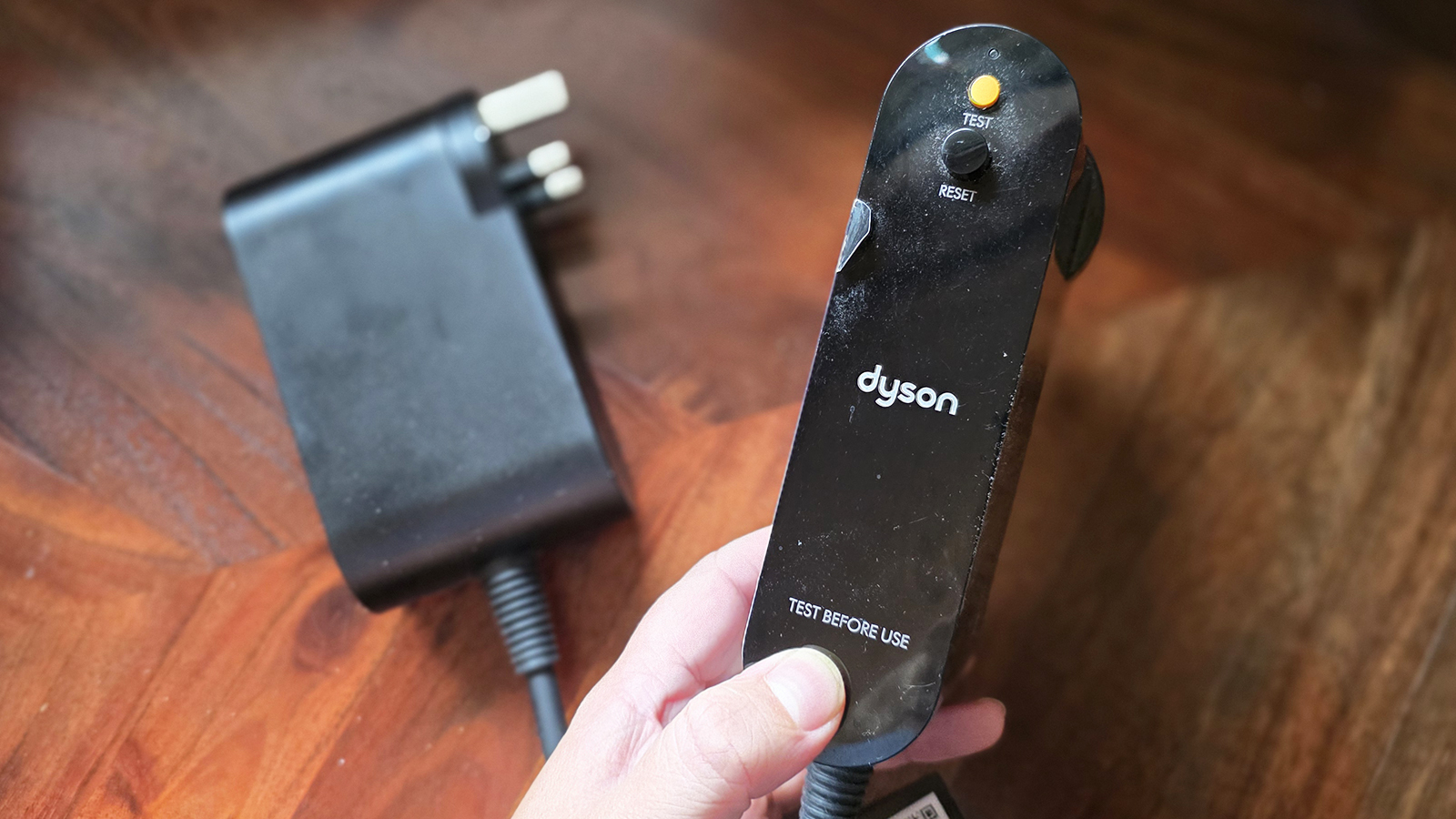
If you’ve unboxed a new hair tool or countertop oven recently and found a chunky plug with Test and Reset buttons staring back at you, you’re not imagining it.
Over the past year, we’ve tested products like the Ninja Artisan pizza oven, the Dyson Airstrait, and the Dyson Supersonic, and several arrived with oversized plugs that asked us to “test” before they’d even switch on. It’s a small friction point, but readers keep asking: Why are brands doing this now, and should you avoid products with these giant plugs?
Short answer: It’s about safety and compliance, especially around water and high heat.
Longer answer: Different categories are converging on similar protective technologies, and the plugs have to house them.
I’ve pulled together what these devices do, why you’re seeing them more often, and the practical trade-offs to consider before you buy.
What that Test/Reset brick actually does
That “giant plug” is almost always an appliance-level safety device that cuts power if it detects a leakage current, exactly the kind of fault that can happen if a product gets wet, a cord is damaged, or a component fails.
You’ll see a few names for it:
ALCI (Appliance Leakage Current Interrupter): Common on hair dryers and hair tools in the U.S.
GFCI (Ground Fault Circuit Interrupter): Often used for outdoor or damp-area appliances in the U.S.
RCD/PRCD (Residual Current Device/Portable RCD): The UK/EU equivalent concept.
Functionally, they all do the same thing: constantly monitor the current flowing out and back. If the device senses an imbalance, say, current “leaking” through water, it trips and shuts off power in milliseconds. The electronics and relay that make this possible are why the plug is, well, big.
Leyland Clowsley, managing director at Apex Manufacturing, says: “Those oversized plugs you see on modern devices are doing more than taking up space; they are mini power management systems… often housing surge protection, voltage regulation, and even embedded transformers that previously sat inside the device itself.”
Note: Not every big plug is doing the same job. On hair tools and high-heat appliances, the “brick” typically provides ground-fault protection (ALCI/GFCI/RCD). On many low-voltage electronics (laptops, routers), the brick is an external power supply that steps wall AC down to safe DC and adds regulation and filtering.
“The plugs themselves tend to contain an entire power supply system… to accept 120V or 240V AC and step it down to a much lower and safer DC output,” explains Jacob Kalvo, founder & CEO at Live Proxie.
Why you’re seeing them more now
In the U.S., hair dryers and many hair tools have included ALCI protection since the early 1990s as part of safety standards. Newer devices, such as the Dyson Airstrait and Supersonic, are powerful, used in bathrooms, and sold across regions with varying building codes. Including the safety device in the plug helps brands meet or exceed requirements regardless of where you use them.
“Compliance with strict international safety standards also requires bigger plugs”, says Lynden Singh, eCommerce director at Laptop Station. “That’s why we now see widespread adoption across brands.”
Verdict: Worth the bulk. For anything you’ll use near a sink, this is non-negotiable protection.
Countertop “outdoor-adjacent” cooking is booming
Appliances like pizza ovens and grills blend indoor convenience with outdoor-style heat and wattage. In the U.S., kitchens and outdoor areas are supposed to be on GFCI-protected circuits, but older homes and extension setups don’t always comply. Building ground-fault protection into the plug ensures protection even if your outlet isn’t up to modern code.
“As devices have gotten smaller and more powerful, the need for external plug‑based protection has increased” says Clay Hamilton, engineer and founder of Patriot Dirt. “Companies will take to larger plugs to decrease failure rates, comply with regulations, and relocate certain components from inside the casing.”
Verdict: A smart belt-and-braces approach for high-heat gear, especially if you’ll use it outside or in garages and patios.
One global product, many electrical realities
A single model may be sold into homes with different wiring ages and safety protections. By integrating intelligence into the plug, brands can standardise safety performance across markets, even when consumer unit or outlet protection varies.
“Two key factors prompted the shift,” Crosley told me. “First, thermal management. Moving these components outside the central unit helps prevent internal overheating. Second, standardisation and cost. It was cheaper and more modular to produce universal power bricks and offload the complexity from the product to the plug.”
Verdict: Sensible for consistency, and fewer region-specific parts help with manufacturing and recalls.
Self-test is becoming a standard practice
Some devices won’t power on until you press Test and then Reset. That’s not just brand theatrics, as it verifies the safety circuit is functioning before you use a high-heat or water-adjacent product. Manuals typically recommend repeating this monthly.
Verdict: Mildly annoying at first, but reassuring thereafter.
Legal and warranty realities
Adding appliance-level protection lowers risk for everyone. It can help prevent injuries and reduce the risk of costly recalls when products are used in non-ideal conditions (older outlets, damp spaces, extension cords).
As Singh puts it, “The increased scrutiny provided by social media has led companies to become more safety‑conscious today than ever before.”
Verdict: You may never notice it working, and that’s the point.
Pros and cons
Pros:
Safety anywhere: Protection travels with the appliance, not just the outlet.
Fast fault detection: Trips in milliseconds if something’s wrong.
Clear diagnostics: If the device won’t reset, you know not to use it and to contact support.
Cons:
Bulk and blockage: They can hog neighbouring outlets on crowded strips.
Weight and fit: The plug can feel heavy in loose or older sockets.
Replacement complexity: If the safety plug fails, you can’t swap it for a basic one, as it’s part of the certified safety system.
Smart plug conflicts: High-wattage devices and safety plugs often don’t play nicely with compact smart plugs, and many brands advise against using them anyway.
How to live with them (safely)
Do the test: Press Test, confirm the device powers off, then press Reset before first use and monthly thereafter. If it won’t reset, stop using it and contact the manufacturer.
Don’t defeat the safety: Avoid adapters that remove grounding or bypass the safety plug. That defeats the entire system.
Mind the outlet: If your plug blocks adjacent sockets, a short, heavy-duty, grounded “outlet saver” extension can help, provided it’s rated for the appliance’s wattage. Many manufacturers discourage extension cords entirely, so check your manual first.
Check your circuit: For U.S. readers, kitchens, bathrooms, and outdoor outlets should be on GFCI-protected circuits. If yours aren’t, an electrician can update them, which is beneficial for every appliance you own, not just this one.
Not every giant plug is the same
Safety interrupters (ALCI/GFCI/RCD), common on hair tools and damp‑area appliances, monitor leakage current and cut power instantly during faults.
External power supplies (“power bricks”), common on laptops, routers, and some smart‑home gear, meanwhile, convert high‑voltage AC to low‑voltage DC and add regulation and surge suppression.
“Delicate electronics can’t tolerate variations, so these adapters incorporate filtering of electrical noise and voltage regulation,” says Kalvo.
Singh adds that today’s larger connectors “offer better power‑management systems” and “contain surge protection, voltage regulation to safeguard sensitive electronics against electric spikes”.
Why some bricks are big, and why some are shrinking
Efficiency and regulation: Global rules like U.S. DOE Level VI and the EU Eco‑design directive pushed adapters to waste less energy as heat, idle less, and convert more efficiently, one driver of bigger, more capable plugs, according to Kalvo.
Thermal and reliability: Shifting heat‑generating components out of slim devices improves longevity and reduces failure rates, notes Clowsley.
The GaN shift: “GaN transistors are far more efficient… you can now buy a GaN charger that’s smaller than a pack of cards and delivers 100W of power,” says Kalvo, evidence that newer materials are shrinking bricks again without sacrificing protection.
Is the giant plug worth the hassle?
For hair tools: Yes. The safety benefit outweighs the bulk, and in many regions it’s a requirement. If you’re buying something like the Dyson Airstrait or Supersonic, factor in the larger plug as part of the package.
For high-heat countertop ovens and grills: Also yes. Especially if you’ll use them outdoors or in older kitchens. The plug-level protection is a safety net you want.
For tight spaces or smart-home setups: Plan ahead. These plugs can block neighbouring outlets and may not be compatible with compact smart plugs. If automation is essential, consider manufacturer-approved solutions or appliances that feature built-in scheduling and controls.
Bottom line
Those oversized plugs with Test and Reset are here because our appliances are getting hotter, more powerful, and more portable, while our homes are a patchwork of old and new wiring. The electronics that can detect a dangerous fault in milliseconds need a bit of room, and that’s the brick you’re seeing.
As Singh puts it, “compliance with strict international safety standards” and a stronger safety culture are pushing brands to build more protection into the plug itself.
And as Kalvo notes, materials like GaN are already helping shrink some bricks again, without compromising safety or efficiency.
Yes, the bulk can be inconvenient. But the trade-off is meaningful: consistent, portable protection that works regardless of where you plug in. For most people, that’s a smart, safety-first evolution, worth the extra inch of plastic on the end of the cord.
More from Tom’s Guide



